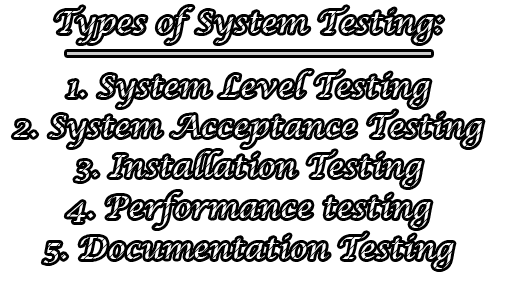System Testing
The process of performing a variety of tests on a system to explore functionality or to identify problems. System testing is usually required before and after a system is put in place. A series of systematic procedures are referred to while testing is being performed. These procedures tell the tester how the system should be performed and where common mistakes may be found. System testing actually a series of different tests whose sole purpose is to verify that the system meets its specified requirements. In this article, we are going to present to you the types and Importance of System Testing.
Definition of System Testing
“System testing is a testing technique while performed to evaluate the complete system the compliance of the system against specific requirements.”(Tutorials Point)
“System testing is testing conducted on a complete integrated system to evaluate the system’s compliance requirements.”(Wikipedia)
“System testing is a phase in the software testing cycle where a total & integrated application/system is tested.”(Techopedia)
Types of System Testing:
There are several types of system testing that can be done as part of the system testing and delivery process. Although the focus on types may vary on the basis of product, organization processes, timeline, and requirements. There are main five types of system testing are given below with a short description:
1. System Level Testing: There are three levels of testing to be performed in system level testing. These are as laid down:
a. Unit testing: It is the best test performed on individual events or modules of a program. In other words, it is the testing of an isolated subset of a program. Basically, unit testing is typically carried out by the developer.
b. Integration testing: In this testing phase, different modules are combined and tested as a group to make sure that the integrated system is ready for system testing. The test is done under the supervision of designers.
c. System testing: is performed on a complete, integrated system. This test is done in the presence of an analyst, designer, and representative.
2. System Acceptance Testing: A system acceptance testing is a final system to accept or reject the system. It is an extensive test that addresses the following levels of acceptance testing:
a. Verification testing: runs the system in a simulated environment using simulated data. This is sometimes called alpha testing.
b. Validation testing: runs the system in a live environment using real data. This is sometimes called beta testing.
c. Audit testing: certifies that the system is free of errors and is ready to be placed into operation.
3. Installation Testing: To make sure that product/software can be installed on a specific or support defined system, can be configured, and can be brought into an operational mode. It includes –
a. Functionality testing: To make sure that the functionality of products is working as per the requirements defined, within the capabilities of the system.
b. Recoverability testing: To make sure how well the system recovers from various input errors and other failure situations.
c. Interoperability testing: To make sure whether the system can operate well with third-party products or not.
d. Robustness system testing: Robustness testing is designed to verify how sensitive a system is toward an error input or how the system behaves in error situations and in a changing operational environment.
4. Performance testing: To make sure the system’s performance under various conditions, in terms of performance characteristics:
a. Scalability testing: To make sure systems scaling abilities in various terms like under scaling, geographic scaling, and resource scaling.
b. Reliability testing: To make sure the system can be operated for a longer duration without developing failures.
c. Regression testing: To make sure that new functionalities added into the system do not break the existing functionalities.
d. Stress testing: This testing generally checks whether the system is going to continue to function when subjected to a large volume of data than expected.
e. Load and stability testing: To test that the system is capable enough to withstand expected load without breaking down. This testing determines, how the application behaves when multiple users access it simultaneously across multiple locations.
5. Documentation Testing: to make sure that the systems user guide and manual are correct, complete, and usable. It includes –
a. Security testing: to make sure that the system does not allow unauthorized access to data and resources.
b. Usability testing: to make sure that the system is user-friendly, easy to use, learn & operate.
c. Compliance & regulatory testing: to test that the system specification and operation complies well with required regulators.
d. Safety assurance: There are two basic tasks performed by a safety assurance engineering team:
- Provide methods for identifying, tracking, evaluating, and eliminating hazards associated with a system.
- Ensure that safety is embedded into the design and implementation in a timely and cost-effective manner.
The Steps of Test an Implemented System:
When we are going to implement a system that time we should follow a few steps which are given below:
Step-1: Preparation of system test plan: The system test plan may vary from organization to organization, working pattern, testing strategy, and plan. Even there are some points in common to be considered in the testing plans given below:
- Goals & objectives
- Scope
- Critical areas to focus
- Test deliverable
- Testing strategy for system testing
- Testing schedule
- Test environment
- Role responsibilities
Step-2: Creation of test cases: In this case, different scenarios and cases of different types of testing have to be written. Different types of testing like verification testing, validation testing, compatibility testing, performance testing, load testing, stress testing, capability testing, etc. have to be considered here. While writing a test case it is needed to ensure covering all functional, and non-functional, user requirements.
Step-3: Creation of test data used for system testing.
Step-4: Automated test case execution.
Step-5: Execution of normal test case & update test case if using any test management tools (if any).
Step-6: Bug reporting, bug verification & regression testing.
Step-7: Repeat testing life cycle (if required)
Importance of System Testing:
Some importances are as being:
- To ensure an error-free system running.
- To ensure durability, stability, and robustness of the system.
- To enhance workability, supportability, and integration of the system.
- To ensure the quality standard product to the end users.
- To validate systems compliance with clients’ functional, technical, and business requirements.
Finally, we can say that system testing is a critically important verification method that takes up a very large portion of the resources of a project, including schedule, budget, staffing & facilities. In addition to defects, detention testing is also performed to provide sufficient objective evidence to justify confidence in the system’s quality, fitness for purpose, and readiness for being accepted and placed into operation.

Library Lecturer at Nurul Amin Degree College










